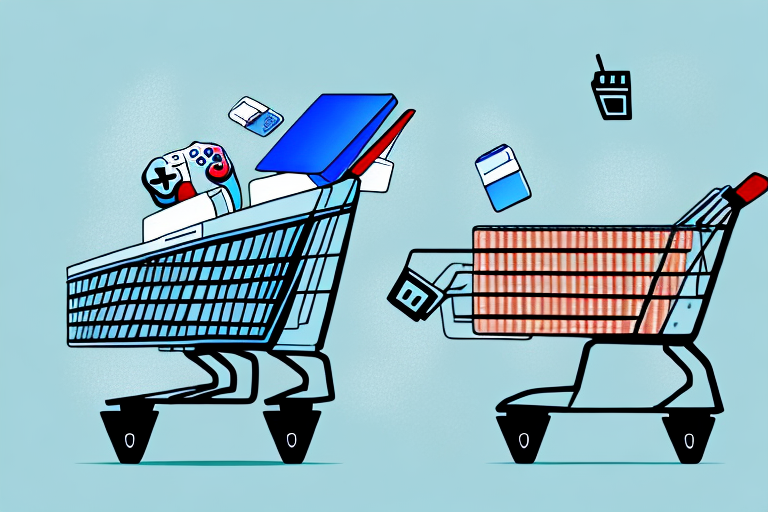.svg)
The Role of Gamification in E-commerce: Increasing User Engagement and Retention
.svg)

Gamification has become a popular strategy in the field of e-commerce, revolutionizing the way businesses interact with their users. By incorporating game elements and mechanics into online platforms, companies are finding innovative ways to increase user engagement and retention. In this article, we will explore the concept of gamification, discuss its benefits in e-commerce, delve into the various elements and techniques involved, and examine real-life case studies to understand its successful implementation.
What is Gamification?
Gamification can be defined as the process of incorporating game-like elements into non-game contexts to drive user behavior and enhance their experience. In the realm of e-commerce, this technique aims to make interactions with online platforms more exciting, enjoyable, and rewarding for users. By tapping into the innate human desire for competition, achievement, and recognition, gamification creates a powerful incentive for users to actively engage with e-commerce websites and apps.
When it comes to gamification in e-commerce, the possibilities are endless. From virtual badges and leaderboards to quests and challenges, businesses are constantly finding innovative ways to make the online shopping experience more interactive and immersive. By adding an element of fun and excitement, e-commerce companies can transform mundane tasks like browsing products and making purchases into engaging and enjoyable activities.
One of the key aspects of gamification in e-commerce is personalization. By tailoring the gaming experience to individual users, companies can create a sense of uniqueness and exclusivity. For example, a clothing retailer might offer a virtual dressing room where users can try on different outfits and receive personalized recommendations based on their style preferences. This not only makes the shopping process more enjoyable but also increases the chances of a successful purchase.
Definition and Explanation of Gamification in E-commerce
Gamification in e-commerce refers to the application of game design principles and mechanics to encourage desired user behavior. Through interactive challenges, personalized experiences, and rewards systems, companies can motivate users to explore products and services, make purchases, and share their experiences with others. By transforming everyday activities into game-like experiences, e-commerce businesses can harness the power of fun and excitement to captivate and retain their user base.
Imagine visiting an online store and being greeted by a virtual shop assistant who guides you through the aisles, recommending products based on your preferences and past purchases. As you browse, you earn points and unlock special discounts or exclusive access to limited edition items. The more you engage with the platform, the more rewards you receive, creating a sense of achievement and progression.
Furthermore, gamification in e-commerce can also foster a sense of community and social interaction. By integrating social features such as user profiles, chat forums, and the ability to share achievements on social media, e-commerce platforms can create a vibrant and engaging community of like-minded individuals. This not only enhances the overall user experience but also encourages users to stay connected and keep coming back for more.
Brief History of Gamification in E-commerce
The roots of gamification in e-commerce can be traced back to the early 2000s when companies started experimenting with loyalty programs and reward schemes to foster customer loyalty. However, it wasn't until the rise of social media and mobile technology that the concept gained widespread popularity. With the advent of smartphones and the proliferation of social networks, businesses began incorporating game elements like badges, leaderboards, and virtual currencies into their online platforms. This marked the beginning of the gamification revolution in e-commerce.
As technology continued to evolve, so did the possibilities for gamification in e-commerce. Augmented reality (AR) and virtual reality (VR) have opened up new avenues for immersive and interactive shopping experiences. Imagine being able to try on clothes virtually, see how they fit and look from all angles, without ever leaving the comfort of your home. This level of engagement not only enhances the user experience but also reduces the risk of purchasing items that don't meet your expectations.
Today, gamification has become an integral part of the e-commerce landscape. From major retail giants to small independent businesses, companies are leveraging game design principles to create unique and compelling online experiences. Whether it's through loyalty programs, interactive quizzes, or virtual treasure hunts, gamification continues to shape the way we shop and engage with brands online.
Benefits of Gamification in E-commerce
Gamification holds immense potential for e-commerce businesses, offering a range of benefits that can significantly impact user engagement and retention. Let's explore some of the key advantages:
Enhancing User Engagement through Gamification
Gamification captivates users by transforming mundane activities into enjoyable challenges. By infusing interactive elements such as quizzes, puzzles, or virtual scavenger hunts, e-commerce platforms can provide an immersive experience that keeps users coming back for more. Engaged users are more likely to spend time on the platform, explore products, and ultimately make purchases, thereby driving revenue for businesses.
Increasing User Retention with Gamification Techniques
One of the greatest advantages of gamification is its ability to improve user retention. By incorporating progress bars, levels, and achievements, e-commerce platforms can create a sense of accomplishment and progression, encouraging users to stay engaged for extended periods. Furthermore, by rewarding users for their loyalty and commitment, businesses can strengthen the bond with their customers, making them more likely to return and continue their engagement.
Boosting Customer Loyalty through Gamification Strategies
Gamification fosters a sense of community and loyalty among users. By implementing social interaction features such as leaderboards, chatrooms, or competitions, e-commerce platforms can create a vibrant and engaging community that users want to be a part of. This sense of belonging and social recognition not only enhances the overall user experience but also increases customer loyalty, leading to repeat purchases and positive word-of-mouth marketing.
Gamification Elements and Techniques in E-commerce
Points, Badges, and Leaderboards: Using Game Mechanics to Drive Engagement
One of the key elements of gamification in e-commerce is the use of points, badges, and leaderboards. Points are awarded to users based on their interactions with the platform, such as making purchases, leaving reviews, or sharing products on social media. Badges act as visual representations of achievements, providing users with a sense of accomplishment and status. Leaderboards, on the other hand, display the rankings of users based on their points, fostering healthy competition among users and encouraging them to earn more points.
Personalization and Customization: Tailoring the User Experience through Gamification
Personalization is a crucial aspect of gamification in e-commerce. By tailoring the user experience to individual preferences and interests, businesses can create a more immersive and relevant experience for users. This can be achieved through personalized recommendations, customized user interfaces, or adaptive content that adapts to users' behavior and preferences. By providing personalized experiences, e-commerce platforms can strengthen user engagement and improve overall satisfaction.
Challenges, Quests, and Rewards: Encouraging User Participation and Progression
Challenges and quests are powerful tools in gamification that encourage user participation and progression. E-commerce platforms can create interactive challenges and quests that encourage users to explore various product categories, discover new items, or complete specific tasks. By rewarding users for completing these challenges, such as offering discounts, exclusive offers, or unlockable content, businesses can motivate users to actively engage with the platform and make repeat visits.
Social Interaction and Competition: Fostering Community Engagement in E-commerce
Gamification thrives on social interaction and competition. By incorporating social features like chatrooms, forums, or user-generated content, e-commerce platforms can facilitate interactions between users, fostering a sense of community and connection. This social engagement not only enhances the overall user experience but also drives user retention and loyalty. Additionally, friendly competition through leaderboards or challenges encourages users to compete with one another, driving engagement and motivating them to achieve higher rankings or rewards.
Case Studies: Successful Implementation of Gamification in E-commerce
Case Study 1: How Company X Increased User Engagement and Retention through Gamification
In this case study, we will examine how Company X successfully implemented gamification techniques to increase user engagement and retention on their e-commerce platform. By incorporating interactive challenges, personalized recommendations, and a loyalty rewards program, Company X was able to create an engaging and rewarding experience for users. As a result, they saw a significant increase in user engagement, higher retention rates, and improved customer satisfaction.
Case Study 2: The Impact of Gamification on Conversion Rates at Company Y
Company Y, a leading e-commerce brand, implemented gamification strategies to improve their conversion rates. By leveraging game mechanics such as progress bars, limited-time challenges, and exclusive rewards, Company Y created a sense of urgency and excitement among users. This resulted in a substantial increase in conversion rates, as users were motivated to complete purchases to unlock rewards or achieve higher levels. Company Y's success showcases the transformative power of gamification in driving conversions and boosting sales.
Case Study 3: Gamification Strategies that Led to Increased Customer Lifetime Value at Company Z
Company Z sought to increase their customer lifetime value by implementing gamification strategies on their e-commerce platform. By gamifying the shopping experience, offering personalized recommendations, and incentivizing repeat purchases through loyalty rewards, Company Z was able to create a loyal and engaged customer base. This led to higher average order values, increased customer retention, and ultimately, a boost in customer lifetime value.
In conclusion, gamification is a powerful tool that can revolutionize the e-commerce industry by enhancing user engagement and retention. With its ability to transform mundane activities into interactive and rewarding experiences, gamification offers numerous benefits for businesses, including increased user engagement, improved customer loyalty, and higher conversion rates. By incorporating game elements and techniques into e-commerce platforms, brands can create a captivating user experience that drives long-term success.
Related Posts
Let's
Let’s discuss how we can bring reinvigorated value and purpose to your brand.







.svg)